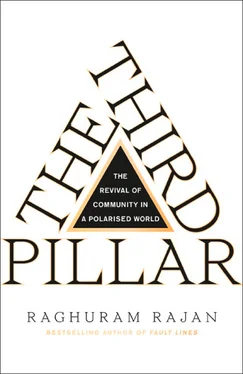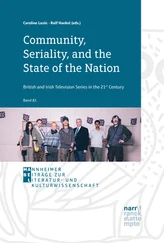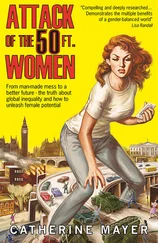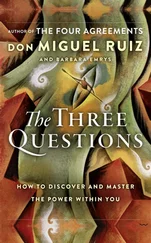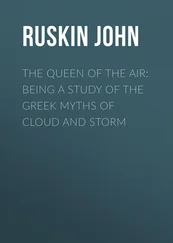What was different in northeast Germany (and Eastern Europe more generally) from England was that the peasant did not have much market choice himself. Central authority was weak and there were no royal courts that might have protected his rights against the nobility. Moreover, even though it was a common feudal practice that a serf who escaped the manor and lived in a town for a year and one day became free, towns had declined in size and prosperity in northeast Germany, and there were not enough of them to hide him or give him a livelihood, unlike in more urbanised England. In Poland, the land market was suppressed because of laws that prevented ownership from passing outside nobility. 45As a result, rich businessmen, lawyers, and merchants could not buy land, put it to more efficient use, and put pressure on feudal arrangements. With few checks on the power of the landed nobility, market pressures increased peasant oppression and feudal obligations rather than diminishing them. Even today, perhaps because it stayed feudal much longer, much of northeast Germany is less prosperous than southern Germany.
CONCLUSION
The absolute monarchy symbolised by the Tudors and attempted by the Stuarts gave way to a state that obtained more capabilities after giving up its power to be arbitrary. Such a state enjoyed broader legitimacy among the propertied because of the widespread belief that it would continue to adhere to a social contract with its wealthier citizens and investors. This also assured it of access to finance from the wealthy. With the confidence that it had few domestic challenges to its legitimacy, and that it could borrow the money to meet external challenges when that necessity arose, the state did not need to favour a select few. It could operate at greater arm’s length from the market. Cronyism steadily gave way to a more open business environment, which in turn created many more competitive independent entities that could check state power.
As England became militarily powerful on the basis of its strong state finances, and economically powerful based on its competitive markets (which positioned it well for the Industrial Revolution), other European countries took note. They did not want to lose out in the great European quest for supremacy. It would be too much to claim there was only one way to a constitutionally limited state. The United States, despite inheriting a very English governance ethos and becoming an independent republic, went through a civil war to suppress its own Southern landed interests. 46France went through a bloody revolution, followed by war and empire before it eventually became a constitutional republic (barring a few short relapses). Germany went through unification, empire, war, democracy, fascism, and war again before it too became a constitutional republic. As we will see, the United States played an enormous role in post–Second World War Western Europe in ensuring that countries continued to see value in both a democratic limited state and in markets. Nevertheless, many Western European countries needed only a nudge postwar, because the underlying distribution of political power and the existence of structures promoting competitive markets made them fertile ground for creating a constitutionally limited state.
The recognition of private property in land, and the emergence of a market for produce and land, also hurt many as the feudal community was destroyed. While independent private property owners could coordinate through Parliament or Congress to influence the state, the peasant and increasingly the worker in manufacturing establishments, dislodged from their traditional communities, had no explicit rights and no say in their own governance. In the next chapter, we will track the final steps toward liberal democracy as industrialisation picked up. The demand for a voice came especially from workers in the growing cities, whose squalid filthy communities needed public services. Having obtained democracy, as we will see in the next chapter, communities organised to get the political establishment to pay attention to their demands, especially that unbridled crony capitalism be controlled. The third pillar grew in strength once again.
3
FREEING THE MARKET … THEN DEFENDING IT
As the state eliminated military challenges within its territory, and as parliamentary bodies came to be dominated by propertied individuals, the wealthy no longer felt their lives or property were under constant threat. Parliament would limit the government to legitimate activities. With the state constitutionally limited, trade- or community-based organisations that would provide members physical security and protect their business were no longer required. Nor were restraints on competition that made these organisations possible. Economic philosophers could now preach the virtue of free and unfettered markets, while political philosophers could extoll the benefits of individual liberty and minimal government, even while both sets of thinkers took the safety of life and wealth for granted. In the eighteenth and nineteenth centuries, markets were on the ascendance.
Laissez-faire, first propounded by French philosophers known as the Physiocrats, sought to take the emerging relationship between the state and markets to its logical conclusion: the state should leave business alone to do what it must, letting the full forces of market competition play out. The philosophers did not explain what they would advocate if market participants tried to subvert market competition with the aid of the state – a development that Adam Smith worried about – or shut it down themselves by cartelising the market. Nevertheless, as a blunt theoretical argument with which to bludgeon the remaining anticompetitive vestiges of both feudalism and mercantilism, laissez-faire was successful.
Yet, even as the votaries of the market celebrated, opposition was building. Not everyone benefited from the commercialisation of agriculture, even in England. There were losers other than the high aristocracy, most importantly those who benefited from the old manor community. The worst affected were older peasants, whose tenancy was terminated as their fields were given over to more productive uses or users, but who could not migrate to the towns unlike the young. Peasants also saw their customary right to graze animals, hunt for game, or pick firewood in the commons disappear without compensation, as the common grounds were legally enclosed and appropriated by the politically powerful landed. As a popular ditty went:
The law locks up the man or woman
Who steals the goose from off the common
But leaves the greater villain loose
Who steals the common from the goose. 1
The commercialisation of agriculture broke up many a traditional English village community, resulting in masses of unemployed peasants who migrated to the towns in search of work. This was Marx’s ‘reserve army’ of the unemployed, which fed the Industrial Revolution.
The jobs in the hellish factories that mushroomed in the growing towns were hard and dangerous. They did put food on the table but too many children worked long hours, simply because they were more nimble than adults, and parents did not know where to leave them while they worked. Families had few alternatives since work back in the village had disappeared. Worse than the factory jobs were the appalling, polluted, overcrowded, and unsanitary urban ghettos where the workers lived. Few employers were enlightened enough to do anything about these living conditions. With everyone subsisting at the margin, there was little sense of community, let alone community support in these anonymous, unfamiliar industrial towns. Every worker feared the job losses from the emerging business cycles and financial booms and busts, which could quickly convert a barely tolerable existence into utter destitution.
Читать дальше
